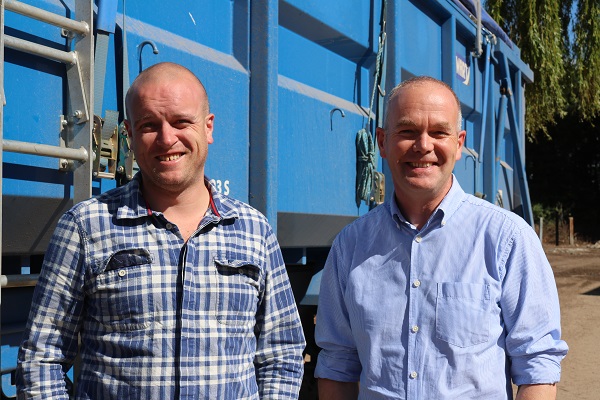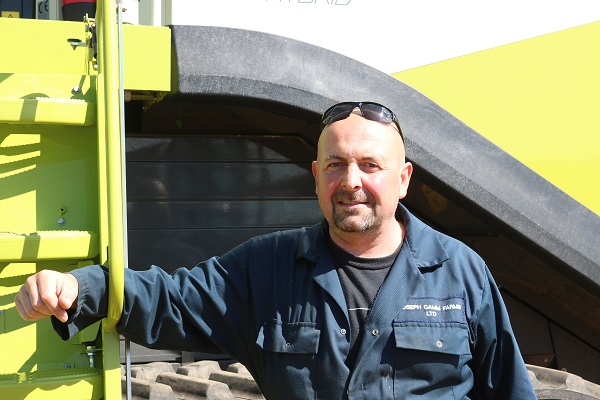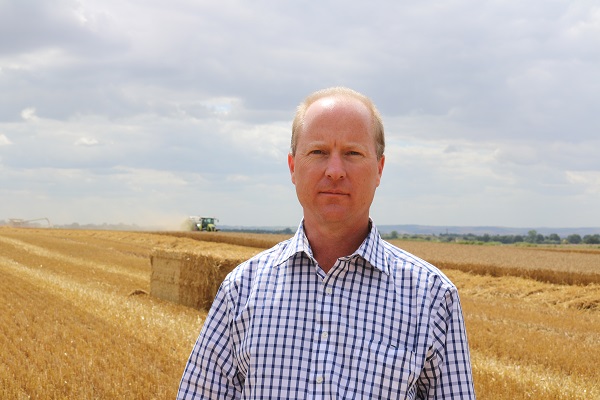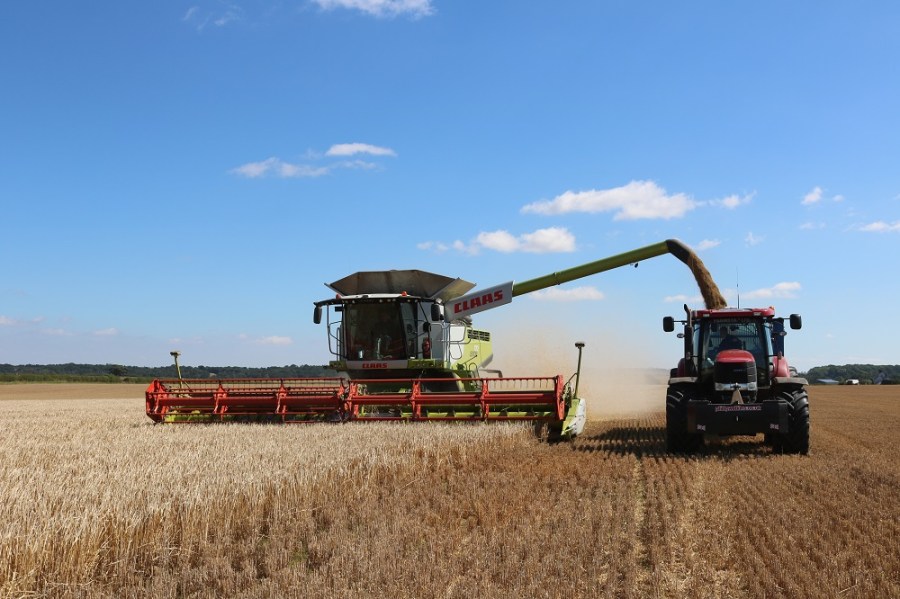Telematics keeps your finger on the pulse of harvest from the farm office, and can even deliver it to your smartphone. CPM visits an arable business in Notts to find out how it helps.
The combine’s a very expensive machine, and when it’s in operation, it’s good to know how it’s performing.
By Tom Allen-Stevens
It’s mid harvest, and you’d expect to find a hectic dash of activity in the main yard at Upper Morton, near Retford, Notts – the centre of operations for the 1600ha arable business Joseph Camm Farms.
But there’s a relaxed air of control in the farm office. There is indeed a hubbub of operations carrying on out in the fields – The Sands Vision sprayer is busy applying a blight fungicide to the potatoes, the Claas Lexion 770 combine is cutting a swathe through the spring

Telematics is helping James Bambridge (left) and Mark Pickard keep track of machinery and costs and move towards more automation.
barley, and countless other operations are underway in the farm’s carrots, onions and other crops. But all this activity seems to be coolly and calmly coordinated.
“I don’t have to ring up the combine driver to find out what he’s up to,” explains company secretary Mark Pickard. “All the information, including his exact location, combine throughput, even where he’s unloaded and his fuel use, is downloaded to my PC.”
He makes use of Claas’ Telematics service (see panel on page pxx). All the operational information about the farm’s combine is uploaded to a central server and can be accessed at any time from the farm office. The business has used the system for four years, and it’s a level of automation Mark Pickard values.
“It’s a very useful tool. As a family-owned business, there’s always been an emphasis here on making good use of the latest technology and getting the best out of the equipment we have. The combine’s a very expensive machine, and when it’s in operation, it’s good to know how it’s performing,” he explains.

All the data capture happens in the background, so Paul Everitt can focus on operating the combine.
“Of course, you can opt to download the information from the SD card, but that requires you to get the card, take the information off it, and put it back again. It’s easy to slip up and lose a day’s data.”
The information he receives is almost real-time – there’s around a ten-minute delay – but all of the data ever documented from the machine is available to download through the Claas web-based portal.
“It’s reassuring to know I have access to that data whenever I want it, and can see what happened on any particular day. The level of automation also means minimum input is required from the combine driver – he just drives into the field, the combine recognises where it is and tags the data accordingly.”
So doesn’t the driver feel a little like he’s being spied on? “When we set it up, Paul Everitt, who operates the combine, came into the office and we showed him round the system and what it does. I think it’s actually quite reassuring for him that he knows all the data capture we want just happens in the background, so he can focus on operating the machine. There’s also less manual record-keeping required, so it benefits everyone.”
The system was relatively straightforward to set up – all the fields were exported as polygons from the farm’s Gatekeeper software and imported into the Claas portal. “I went to a training day in Yorks, which has helped ensure I get the most out of the system,” he notes.
“But it’s proved reliable, and you get very responsive support from Claas. The one thing that could be improved is the downloading – it can be tricky to manipulate the files.”
The system doesn’t tie him to the farm office, either – Mark Pickard has the Claas Telematics app on his smartphone so can access information about the combine on the move.
The data itself is used to generate yield maps and analysed to assess field performance. “It’s especially useful to identify areas of compaction,” notes farm manager James Bambridge.
“Some of the lighter soil is prone to manganese deficiency. With a large acreage of root crops, compaction can be a problem and we need to identify problem areas quickly.”
The farm consists of three units that lie in a 20-mile radius, so good planning is essential to keep road travel to a minimum and maintain maximum productivity from the farm’s equipment. “The Telematics also helps from a security point of view – we can track where the combine is at any time,” adds James Bambridge.
“On one unit with heavier land, we’re moving over to controlled-traffic farming. It’ll be a slowish process to find out what works best for us, but the Telematics helps analyse the system and identify where efficiencies can be made.”
This year, the mainline tractors are being upgraded to John Deeres equipped with JD Link, and there are plans to increase the automation and monitoring. “We have a new automated fuel management system, so can monitor this more closely,” he notes.
“Telematics on other equipment only really works where the implements are ISOBUS-enabled – we can’t get the same level of automation on our trailed potato harvester, for example. But as equipment is replaced, it can be upgraded for minimal extra expense and the benefits we get out of the system will build,” he says.
EASY route to reduce paperwork
Claas’ TONI (Telematics on implements) service bolts onto the manufacturer’s EASY (Efficient agriculture systems) – the electronic protocol that sits on its machines and is responsible for equipment settings and performance monitoring.

Automatic documentation allows you to just drive into a field and start a job with all the information recorded for you, says Edward Miller.
In all, there are more than 200 different parameters which, along with a machine’s location, are sent to Claas’ Telematics server via the mobile phone network and can be accessed via the internet by the farmer or by the dealer for remote diagnostics.
“Perhaps the biggest benefit, especially for contractors, is Automatic documentation,” says Edward Miller, EASY product manager for Claas UK. “If you have a TONI-enabled machine, you just drive into a field and start a job and all the information about that job is recorded for you.”
This would include road transport, for those where this is a key part of the job. If an extra field is worked or operation carried out on the day, this is automatically logged and transferred back to the office, so admin staff don’t have to rely on operators for paperwork before sending out invoices. “It doesn’t mean you’ll get paid any earlier, but there’s definitely the potential to improve cashflow if you can get the invoices out promptly,” he points out.
The system works with Claas combines, and self-propelled forage harvesters, Claas tractors and with many ISOBUS-equipped implements if they’re attached to Telematics-enabled tractors. “The data collected depends on the specification of the machine,” notes Edward Miller.
“For a combine, as well as yield, typically you’d monitor idle/harvesting time, fuel consumption and transport, as well as in-field turning, which can all contribute towards improving efficiencies.”
Performance data is accessed via the Claas Telematics web portal, where all TONI-enabled machines are displayed. You can view the data in map views on the Telematics website, and field boundaries can either be imported using existing system data, or plotted straight into the maps.
A smartphone and tablet app is available for both Android and iOS operating systems. It provides access to the same information, while an integrated navigation function shows you the shortest route to your machine.
The service is available for an annual subscription, starting at £200 for Telematics Basics. This provides information on a machine’s position and track on a map, operating status and current fuel level. Upgrading to Telematics Professional, costing £500/year, gets you access to all the machine information, while Automatic Documentation can be bolted on to either package for an extra £300/year.
Real-time logistics
Claas has just launched its Fleetview app, which gives all harvest staff an instant overview of the harvesting operation through an iPad. “It shows you exactly where the combine is, how fast it’s travelling and how full the tank is, and locates all the trailers,” explains Edward Miller.
“The app means the combine operator can coordinate with the trailer drivers far more efficiently, which potentially reduces downtime and allows less trafficking on the field.”
The licence costs £250/year and covers one combine and up to five trailers. For more than one combine, you can group licences, so up to 10 trailers can service two combines, for example.
Farm Facts
Joseph Camm Farms, Upper Morton, Retford, Notts
- Farmed area: 1600 ha split across three units
- Staff: 10 full-time, plus Mark Pickard and James Bambridge
- Soil types: Sandy loam, limestone, heavy clay
- Cropping: Winter wheat, spring barley, winter oilseed rape, winter barley, sugar beet, potatoes, carrots, onions
- Mainline tractors: Switching to John Deere 8370, 8320, 7250; 2x New Holland; 5x Case IH Puma
- Combine: Claas Lexion 770 with 10.7m header
- Potato harvester: Grimme GT170
- Drills: 6m Väderstad Rapid; 4m Accord spring-tine combination
- Sprayer: Sands Vision with 5500-litre tank and 36m boom
- Spreader: Kuhn trailed 6000-litre with 36m boom
- Loaders: Manitou 2x 735, 741




